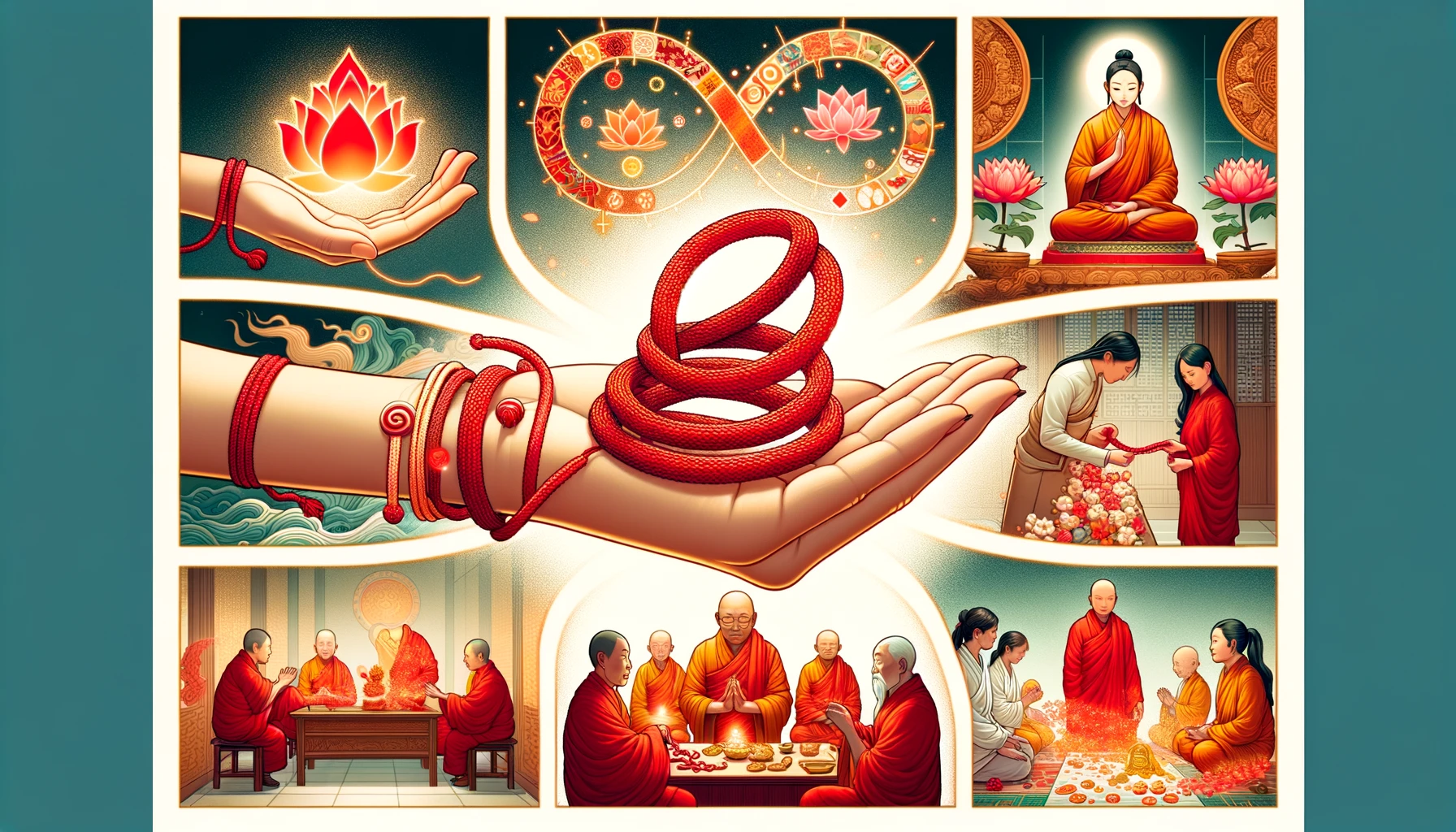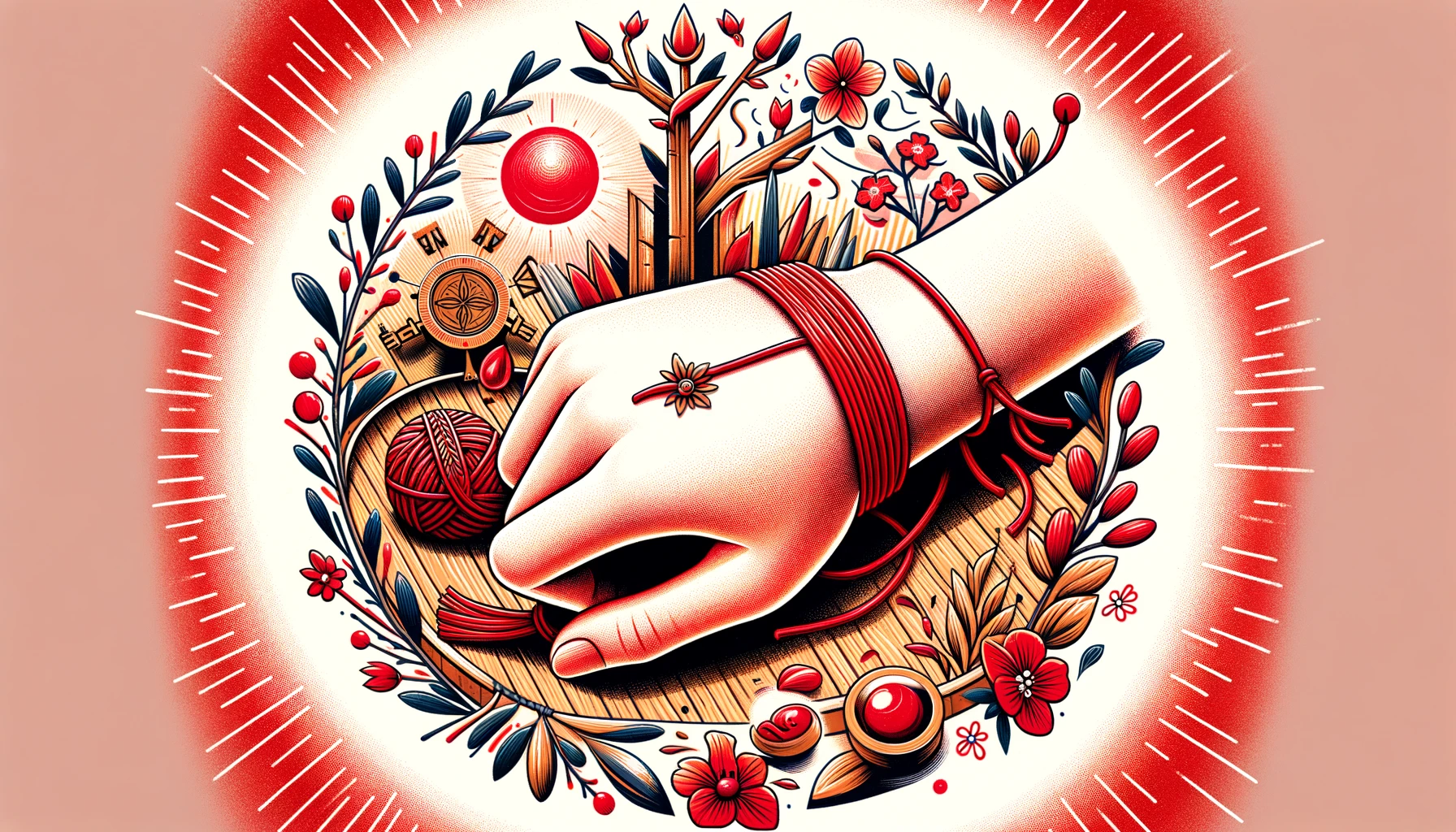Red bracelet meaning
The red string bracelet, an accessory rich in cultural and spiritual symbolism, transcends geographical boundaries and religious traditions. While it may appear as a simple piece of jewelry, the meanings and beliefs attached to it vary significantly across different cultures, each imbuing it with unique significance. From Kabbalah in Judaism to the ancient Chinese legend of the Red Thread of Fate, the red string bracelet embodies a plethora of interpretations including protection, connection, destiny, and good fortune.
In this exploration, we delve into the varied and fascinating interpretations of the red string bracelet across several cultures: Kabbalah (Judaism), Hinduism, Buddhism, Chinese culture, Greek culture, Latin American cultures, and Christianity. Each section provides a deep dive into the cultural and religious contexts that give this simple red string its profound meanings. Whether worn as a talisman against evil, a reminder of spiritual commitments, or a symbol of destined connections, the red string bracelet reflects the diverse tapestry of human beliefs and the universal quest for protection, luck, and connection
Red bracelet meaning in Kabbalah (Judaism)

In the mystical Jewish tradition of Kabbalah, the red string bracelet is deeply symbolic, offering protection and fortune. Here's an overview of its significance:
Rooted in Ancient Tradition
This practice is anchored in ancient Hebrew texts. It's primarily linked with safeguarding against the Evil Eye, a concept widely recognized in various cultures for its malevolent implications.
Connection to Rachel
The red string is tied to the story of Rachel, a revered figure in Jewish lore. Struggling with infertility for years, Rachel's eventual motherhood to Joseph and Benjamin is a tale of faith and perseverance. Her demise during Benjamin's childbirth and her enduring protective instinct towards her children have cemented her status as a sacred maternal figure.
Ritual at Rachel's Tomb
In homage to Rachel, a ritual involving wrapping a scarlet thread around her tomb seven times emerged. This act is believed to imbue the thread with protective energies and good luck. It's then fashioned into bracelets and tied around the left wrist, accompanied by a prayer for protection.
Worn on the Left Wrist
The bracelet is typically worn on the left wrist, viewed as the receiving side of the body, closer to the heart. This positioning is thought to enhance the wearer's ability to receive positive energy and protection.
Symbolism and Modern Use
Beyond physical protection, the red string bracelet also symbolizes strength, resilience, and divine presence in daily life. The vibrant red hue is seen as a beacon of positive energy, attracting good luck and repelling negativity. Today, its significance extends beyond religious boundaries, recognized as a universal emblem of spiritual safeguarding, mindfulness, and positive intentions.
A Universal Symbol
Transcending its religious origins, the red string bracelet in Kabbalah represents a blend of ancient wisdom and contemporary relevance. It underscores a universal message that resonates across cultures: the need for protection, the power of connection, and the pursuit of good fortune.
The red string bracelet in Kabbalah beautifully demonstrates how a simple object can carry profound, multifaceted meanings, bridging the gap between ancient traditions and modern life's challenges and aspirations
Red bracelet meaning in Hinduism

In Hinduism, the red string bracelet, often referred to as "Kalava" or "Mauli," carries a multitude of symbolic meanings and is deeply ingrained in religious and cultural practices. Its significance varies across different regions and communities within Hinduism, embodying concepts of protection, faith, and in some cases, marital status.
Symbol of Sanctity and Protection
The red string in Hinduism is widely recognized as a sacred symbol. It's commonly used during religious ceremonies and significant occasions, representing the sanctity of these events. The red string serves as a physical manifestation of religious and cultural values, emphasizing the importance of the occasions where it's worn.
Marriage and Gender-Specific Practices
In the context of marriage, the wearing of the red string varies between genders. Married women typically wear the red string on their left wrist, while men and unmarried women wear it on their right wrist. This practice not only signifies marital status but also is a symbol of protection and good luck for the wearer.
Ceremonial Importance
During religious events, especially in Hindu rituals (pujas), the red string is tied around the wrist by a priest or an elder family member, symbolizing a blessing and protection for the individual. This act also serves as a physical reminder of the wearer's religious and spiritual commitments.
Variations Like Kautuka
The red string, sometimes combined with yellow or white, is known as "Kautuka" in some Hindu practices. This variation of the red string is especially used to ward off bad luck and is ceremonially tied during specific rituals, such as Yajna ceremonies or when tying it around sacred objects.
Unity in Diversity
The act of tying the red string during religious ceremonies represents unity among Hindus, regardless of their regional and cultural differences. It serves as a unifying symbol that transcends individual beliefs, bringing together people in their shared faith.
The red string bracelet in Hinduism is thus a potent symbol, intertwining religious significance, cultural identity, and social practices. It's a visual representation of faith, a protective charm, and a reminder of the wearer's spiritual and cultural heritage. This tradition, rich in symbolism, is a testament to the diverse and profound practices found within Hinduism
Red bracelet meaning in Buddhism

In Buddhism, the red string bracelet is imbued with deep spiritual meaning and is used in various practices and ceremonies. Its significance encompasses concepts of compassion, connection, and the cyclical nature of life.
Symbol of Compassion and Mindfulness
The red color in Buddhism is often associated with compassion, a central tenet of Buddhist teachings. Wearing a red string bracelet is seen as a reminder to cultivate compassion and empathy towards others. It serves as a physical symbol to be mindful of one's actions and words, aligning them with the principles of kindness and understanding.
Connection to the Samsara Cycle
The knotted red string bracelet in Buddhism also symbolizes the endless cycle of birth, death, and rebirth, known as Samsara. This continuous loop reflects the Buddhist belief in the interconnectedness of all life and the universe. The bracelet, therefore, symbolizes the wearer's acknowledgment and acceptance of this fundamental concept.
Use in Ceremonies and Blessings
In Buddhist traditions, red string bracelets are often used in ceremonies, where they are blessed by monks. The blessing imbues the bracelet with spiritual energy and serves as a token of protection and good fortune for the wearer. It's common for these bracelets to be given to followers as a symbol of their participation in a religious ceremony or as a reminder of their spiritual commitments.
Representation of Good Fortune and Health
Beyond its spiritual symbolism, the red string bracelet in Buddhism is also believed to bring prosperity, good health, and long life. It's a talisman that is thought to attract positive energy and ward off negative influences.
Universal Symbol of Spiritual Connection
The use of the red string bracelet extends beyond specific rituals, becoming a universal symbol of spiritual connection and mindfulness in daily life. It reminds wearers of their spiritual journey and the importance of maintaining a harmonious balance with the world around them.
The red string bracelet in Buddhism thus represents a rich tapestry of meanings, from fostering compassion to symbolizing the cyclical nature of existence. It's a simple yet powerful reminder of the core principles of Buddhism, encouraging wearers to live a life of mindfulness, empathy, and spiritual awareness
Red bracelet meaning in Chinese culture

In Chinese culture, the red string bracelet holds a unique and romantic symbolism, deeply embedded in folklore and tradition.
Red Thread of Fate
The most prominent association of the red string in Chinese culture is with the legendary "Red Thread of Fate" or "Red Thread of Marriage." This concept is rooted in an ancient Chinese belief that the gods tie an invisible red thread around the ankles of those that are destined to meet or help each other in a certain way. This thread may stretch or tangle but never breaks. This legend symbolizes a predestined, unbreakable bond between soulmates or significant people in one's life.
Connection to Yue Lao
The Red Thread of Fate is often linked to Yue Lao, the Chinese God of marriage and love. According to folklore, Yue Lao ties a red thread connecting two people who are destined to be together or have a significant impact on each other's lives, regardless of time, place, or circumstances. This belief encapsulates the idea of destined relationships, be they romantic, familial, or platonic.
Modern Interpretation and Usage
In contemporary times, this tradition has evolved, blending ancient beliefs with modern practices. The red string bracelet is now a popular accessory worn by many, symbolizing the hope and belief in the power of destined connections. It's a token of faith in the idea that meaningful relationships are preordained and will manifest in one's life.
Symbol of Good Luck and Protection
Beyond its romantic connotations, the red string bracelet in Chinese culture is also believed to bring good luck and protection. It's seen as a talisman against misfortunes and negative energies, often worn to attract positive experiences and relationships.
Cultural and Emotional Significance
The red string bracelet in Chinese culture extends beyond a simple accessory. It represents deep-rooted cultural beliefs in fate, destiny, and the interconnectedness of human relationships. It's a symbol of hope and trust in the universe's plan for personal connections and life paths.
In essence, the red string bracelet in Chinese culture is a beautiful blend of mythology, spirituality, and cultural tradition, symbolizing the profound human belief in destiny, connection, and the enduring power of relationships
Red bracelet meaning in Greek culture

In Greek culture, the red string bracelet, known as "Martis," holds a unique and seasonal significance, particularly connected to the beginning of spring.
Symbol of Spring's Arrival
The tradition of wearing the red string bracelet, "Martis," is predominantly associated with the arrival of spring. It is a custom mainly observed during the first day of March. This practice is steeped in the anticipation of the rejuvenation and awakening of nature that spring brings.
Protection Against the Sun's Power
One of the key reasons behind this tradition is the belief that the red string bracelet protects from the strong sun of the early spring. The bracelet is thought to shield the wearer, especially children, from the sunburns that are common during this time of the year as the sun begins to shine more powerfully.
Tied at the Beginning of March
The "Martis" bracelet is traditionally tied around the wrist on the first day of March. It symbolizes the transition from the harsh winter to the more temperate and life-giving spring season. This practice is a physical representation of welcoming the new season and all the positive changes it brings.
Worn Until the End of the Month
The custom involves wearing the bracelet throughout the month of March, until the end of the month or until the first signs of blooming spring are visible. Once these signs are observed, the bracelet is often removed.
Connection to Ancient Rituals and Beliefs
This custom is believed to have its roots in ancient Greek rituals and beliefs. The use of the red color, which is vibrant and full of energy, is thought to be a ward against misfortune and negative influences, a common theme in many cultures' use of red in protective amulets and garments.
In summary, the Greek tradition of the "Martis" red string bracelet is a seasonal cultural practice that marks the transition from winter to spring, symbolizing protection and the celebration of nature's renewal.
Red bracelet meaning in Latin America

In Latin American cultures, the red string bracelet, often worn by newborns, carries a distinct meaning centered around protection and warding off evil.
Protection of Newborns
A prevalent belief in many Latin American countries is that the red string bracelet serves as a protective charm for newborn babies. It's commonly tied around the wrists or ankles of infants. This practice reflects the deep-rooted cultural emphasis on safeguarding the young and vulnerable from negative influences.
Warding Off "Mal de Ojo" (Evil Eye)
The red string is believed to protect against "Mal de Ojo," or the Evil Eye. This concept, widespread in Latin American cultures, suggests that babies and young children are particularly susceptible to the harmful effects of envious or malevolent gazes. The red string acts as a shield against these potentially harmful energies.
Cultural and Superstitious Beliefs
The use of the red string bracelet is deeply intertwined with cultural superstitions and practices. It's a part of a broader range of rituals and customs that are aimed at providing spiritual protection and good fortune to individuals, especially the young.
Syncretism with Religious Beliefs
In some regions, the practice of using red string bracelets blends indigenous beliefs with Christian elements. This syncretism reflects the rich tapestry of cultural and religious influences in Latin America, where ancient traditions often coexist with Christian practices.
Variations Across Countries
The specific practices and beliefs surrounding the red string bracelet can vary from one Latin American country to another. Each region may have its own unique interpretation and way of incorporating the bracelet into its cultural and spiritual life.
In conclusion, the red string bracelet in Latin American cultures is a symbol of protection, particularly for infants, against negative energies and the Evil Eye. This tradition underscores the cultural importance of safeguarding the well-being of the young and is a testament to the rich, syncretic cultural heritage of Latin America
Red bracelet meaning in Christianity

In Christianity, the symbolism of a red string or thread is less prominent as a continuous cultural practice compared to other religions, but it does find mention and significance in certain Biblical narratives.
Biblical Reference to the Red Thread
The most notable mention of a red thread in the Christian Bible is in the Old Testament, in the book of Genesis (38:27-30). In this story, a scarlet thread is tied around the wrist of one of the twin infants, Zarah, during childbirth. This act signifies distinction and is often interpreted symbolically in various ways within Christian teachings.
Symbolism of Redemption and Protection
The red thread in this context is sometimes seen as a symbol of redemption. The color red in Christianity is also associated with sacrifice and the blood of Christ, representing salvation and protection from harm.
Connection with Martyrdom and Fire
Red, as a color, holds significance in Christianity for its connection to the martyred saints, symbolizing the blood they shed for their faith. Additionally, red is associated with fire and the Holy Spirit, especially in the context of Pentecost.
Modern Usage and Interpretation
While the red string or thread is not a widely practiced symbol in contemporary Christianity, its biblical mention and the symbolic meanings associated with the color red have spiritual resonance for some believers. It can be interpreted as a reminder of faith, salvation, and the spiritual protection offered by the Christian faith.
Cultural Integration
In regions where Christianity intersects with other cultural beliefs, such as in Latin America, the red string may blend Christian symbolism with local traditions, showcasing the adaptability and syncretism of religious practices.
In summary, while not a central symbol in Christianity, the red string or thread finds a place in the tapestry of Christian symbolism and storytelling, particularly in its Biblical reference, and can be seen as a marker of distinction, redemption, and protection within the faith.
Conclusion
In conclusion, the red string bracelet serves as a powerful symbol across various cultures, embodying a wide range of meanings from protection and good luck to spiritual connection and destiny. Its significance in Kabbalah, Hinduism, Buddhism, Chinese culture, Greek culture, Latin American cultures, and Christianity illustrates the diverse ways in which a simple symbol can resonate deeply with human experiences and beliefs.
This exploration reveals that, regardless of geographical and cultural differences, there is a common thread – the human inclination towards symbols that offer protection, forge connections, and provide hope. Whether worn as a part of religious practice, cultural tradition, or personal belief, the red string bracelet stands as a testament to the shared human desire for guidance, comfort, and connection in the journey of life.
The red string bracelet, therefore, is more than just a piece of jewelry; it is a symbol that transcends cultural and religious boundaries, reflecting the rich diversity of human spirituality and the universal quest for meaning and protection
